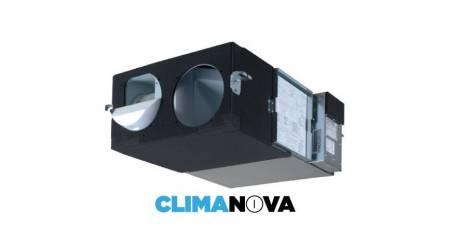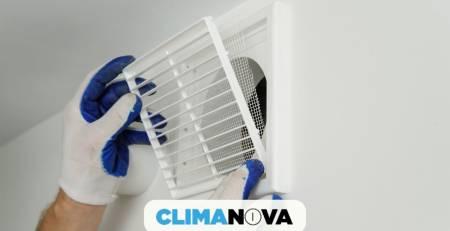Ventilation is a fundamental aspect of maintaining a healthy and comfortable indoor environment in a home. Lack of ventilation can lead to a number of health problems as well as problems for the structure of the home. At Climanova we have extensive experience installing controlled mechanical ventilation (CMV) equipment in single-family homes in Marbella, Estepona and Mijas Costa.
Natural ventilation by opening the windows wide is great, but it is not always ideal. When there are people at home who are allergic to dust, pollen or other substances, it is best to control the air quality. In addition, these systems are very useful for reducing humidity in rooms such as basements, utility rooms, kitchens or bathrooms.
Fresh Air in your Home? Find out why it’s vital
Imagine a home where the windows are closed most of the time. The air inside becomes stale, laden with airborne particles and moisture.
The lack of a ventilation system can lead to a series of problems that affect both the well-being (respiratory discomfort and allergies) of those living in the home, and the structure of the home itself (damp, fungus, etc.). The accumulation of damp can create an environment conducive to the proliferation of mould, affecting the health of the inhabitants and deteriorating the walls and ceilings.
Climanova can offer you solutions to improve the air quality in your home. We are experts in VMC mechanical ventilation systems, offering a range of equipment designed to provide a constant supply of fresh air and eliminate polluted air. These are the main advantages of having a ventilation system:
- Indoor air quality: Adequate ventilation ensures that indoor air is clean and free of contaminants such as allergens, excessive humidity, odours and chemical pollutants.
- Moisture removal: Ventilation helps to control indoor humidity levels. Otherwise moisture build-up can cause problems such as mould growth and degradation of building materials.
- Temperature control: Adequate ventilation can also contribute to temperature control in the home. During summer, ventilation can help dissipate heat build-up indoors, while in winter, it can prevent moisture build-up and condensation on windows.
- Respiratory health: Good ventilation reduces the concentration of particles and allergens in indoor air, which can help prevent respiratory problems and allergies.
How a mechanical ventilation system works
Controlled Mechanical Ventilation or CMV systems in the home ensure a constant flow of fresh air in the home. They are very useful in homes that need to renew the air in areas such as bathrooms, kitchens, basements, indoor swimming pools, spas and gyms where large numbers of people gather.
These are the essential elements of a mechanical ventilation system:
- Extraction system: It uses an extraction system consisting of fans located in strategic places, such as bathrooms and kitchens. These fans extract stale air from the interior and expel it to the outside.
- Supply system: Uses a supply system to bring fresh air into the home. This fresh air is usually filtered before entering to ensure its quality.
- Heat exchanger: Dual-flow systems are the most advanced and include heat exchangers. These devices transfer heat from the stale air being exhausted to the fresh air being introduced. This helps to conserve indoor temperature and reduce heating or cooling costs.
- Automatic Control: Most mechanical controlled ventilation systems adjust the fan speed and the amount of fresh air introduced according to need. This can be based on humidity, CO2 concentration or indoor temperature.
- Maintenance: Regular maintenance of mechanical ventilation systems is important to ensure that they are operating effectively. This includes filter cleaning, component lubrication and periodic inspection.
In general, controlled mechanical ventilation in the home is particularly useful in modern, thermally sealed single-family dwellings, as it helps to prevent the build-up of stale air. They will give you precise control over indoor air quality and can contribute greatly to the comfort and health of your family members.
Differences between single-flow and dual-flow systems
While we mentioned dual-flow systems earlier, it is worth noting that single-flow and dual-flow ventilation systems are two different approaches to providing ventilation in a dwelling. They have similarities, but their main difference lies in the heat recovery unit as we will see below:
- Operation: In a single-flow system, fresh air is brought into the house and stale air is extracted. This can cause a temperature change inside the house. To solve this problem, the double-flow system exchanges heat, so that the incoming air is equal in temperature to the outgoing air.
- Energy Efficiency: Single-flow systems tend to be less efficient in terms of energy conservation compared to dual-flow systems. Causing a temperature decompensation makes the air conditioning system work harder. With dual flow, heat is recovered from the exhaust air and the air conditioning system consumes less energy.
- Air Filtration: Both systems often include filters to improve indoor air quality and control humidity.
As you can see, the main difference between these systems lies in their ability to recover heat or cold during the ventilation process. If the heat exchange does not take place, the air entering the house will be at the outside temperature, which can be either very cold or very hot. If this were the case, it would force the air-conditioning system to work constantly to try to maintain the desired temperature.
Dual-flow systems are more energy efficient and are ideal for maintaining a comfortable and high quality indoor environment. However, they can be more expensive to install than single-flow systems. The choice between the two will depend on the specific needs and the available budget.
If you want to have a controlled mechanical ventilation system or VMC in your home, contact us. Fill in the form below or call us for more information and a personalised quote.



